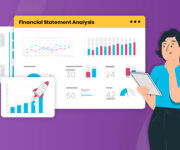The demand for superior credit bureau analysis is higher than ever as the financial lending industry grows exponentially all over the globe. Moreover, with so many mobile and web-based quick loan options available in the market, it has become straightforward for the borrower to get fast money for personal needs or businesses.
As the number of borrowers has increased drastically, the number of payment defaults has also grown proportionately. Reports indicate that non-bank lenders have seen a whopping 50% rise in customers missing payments in the first fortnight of May, threatening to push up overall defaults to perilous levels.
This is where it becomes significant for the lenders, including banks, NBFCs, consortiums, and venture capitalists, to thoroughly analyse the customers’ credit history during the onboarding stage.
What is a Credit Bureau Analyser?
A credit bureau is responsible for collecting various individual data points that determine the person’s creditworthiness. But that raw data may not be sufficient to make risk-free lending decisions in this digital era when customers expect loans to be more readily available than ever.
Hence, specialised software comes into play that analyses the credit reports generated by bureaus, such as a customer’s personal information, credit summary, any inquiries made, foreclosures and repossessions, and public bankruptcy records with advanced AI and algorithms.
Hence, a credit report is a record of a person’s or company’s credit history. And a credit bureau analyser does the job of parsing through the heaps of raw data to provide actionable, meaningful, ready-to-impact feedback points.
The Need for Holistic Credit Bureau Analysis to Ascertain Creditworthiness
The fastest and most effective way to assess the borrower’s creditworthiness is to get access to the credit score. These credit reports and overall credit scores are readily available through the various credit bureaus that collect data from banks regarding the overall fiscal record of the borrower.
This typically includes the summary of how the borrower has handled credit accounts, including the types of accounts and payment history, and certain other information reported to credit bureaus by the lenders and creditors.
Though the credit scores can be easily accessed from any of the four main credit bureaus (CIBIL, CRIF, Experian, and Equifax), the final credit score alone may not suffice for a lender to make a good decision. This is where advanced software with AI-backed predictive analysis and holistic data reports becomes quintessential.
Also read: How Finezza’s Comprehensive Analytics can Simplify Risk Management for Banks and NBFCs
With the growing demand for credit in the market and so many lenders available, Finezza’s credit bureau analysis solution empowers banks, NBFCs, consortiums, and entrepreneurial ventures to make risk-free decisions. Backed by AI-powered predictive analysis and supplemented by detailed data reports from multiple sources, Finezza’s Credit Bureau Data Analyser offers you an all-in-one credit evaluation solution.
Top Features of Credit Bureau Data Analytics Solution from Finezza
Below are the salient features of Finezza’s Credit Bureau Data Analyser.
1. Integration with all main credit bureaus
Finezza’s credit bureau analysis engine integrates with all four main credit bureaus, including:
- CIBIL – CIBIL covers the analysis for individuals as well as businesses. It gives a credit score rating between 300 to 850 – where 720 and above is an excellent score. For companies and other entities, it provides an additional scoring model called PERFORM score.
- CRIF – Approved by the Reserve Bank of India, CRIF conducts credit rating analysis for individuals and corporations. The credit score rating falls between 300-850.
- Experian – A pioneer in generating comprehensive credit scores for both individuals and organisations, Experian takes longer to send reports but is nevertheless worth the wait. The credit scores rating range from 300 to 900.
- Equifax – A more recently established credit bureau, Equifax generates a wide range of credit reports for companies and individuals. The credit score rating from Equifax lies between 1 to 999. For corporations, they also provide credit fraud reports, portfolio management, risk management reports, industry diagnosis, and other reports that may be obtained on request.
All in all, this integration ensures that the credit data analysis coverage is maximum, and the best data from all the credit bureaus are available in a single view. As a result, it provides enormous support for the lender to make an informed decision. In addition, you will not miss any information about the individual or business and can leverage a multi-angle view of various credit bureau analytics to compare credit history.
Also read: What Does Embedded Finance and APIs Mean for the Lending Industry?
2. Credit Focused Grouping
Too much information and too linear fashion make it difficult for the lender to make a good decision. This is where Finezza’s Credit bureau Data Analyser makes a big difference by providing credit-focused grouping. It also provides alerts on essential data points that need quick attention. Besides, it highlights all the potential risks and renders comprehensive and flexible reporting at both micro and macro levels.
3. Borrowing History
Finezza’s credit bureau data analysis provides a detailed view of the entire loan history of the borrower. This includes the following:
- Summary of Borrowings – What is the overall overview of the status of all borrowings in terms of the number of credit accounts, total outstanding credit balance, credit enquiries, etc.?
- Repayment History – Has the borrower been consistent with loan payments and made all payments on time? This can help you gauge the probability that the borrower will meet their payment obligations.
- ‘Enquiry to Success’ ratio – Comparison of the number of loan enquiries made by the borrower and the number of times those were approved.
4. DPD Analysis
A DPD or ‘Days Past Due’ is one of the most crucial elements in the credit report from the credit bureaus. Finezza’s Credit Bureau Analyser tool reads this section in detail and lists all instalments that the borrowers have missed to pay on time. It also reveals the borrower’s credit card bills and whether they have paid their EMIs on time.
5. Access to the Required KYC information
KYC or Know Your Customer is the basic information about the borrower that sets the stage for the entire processing and credit evaluation process. The smart KYC framework gathers data from multiple sources to create a precise picture of the customer’s details. In addition, it makes identity checks as comprehensive as possible by automatically checking personal and business data from various credit bureaus and data points.
Instead of relying on the rudimentary credit score that a single credit bureau provides, you can gather multiple scores and reports from different credit bureaus to come up with a customised credit assessment.
Also read: The Future of SME Digital Lending Beyond COVID-19 Relief Phase
Finezza’s superior credit bureau analysis makes this possible in a single click by gathering data from multiple data points to put together a comprehensive credit evaluation process. As a result, this can help lending institutions decrease costs, identify and profitable onboard borrowers, meet demanding customer acquisition targets, and drastically mitigate credit risk or payment defaults.




Leave a Reply